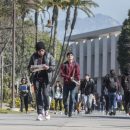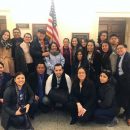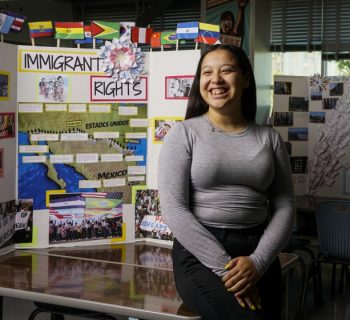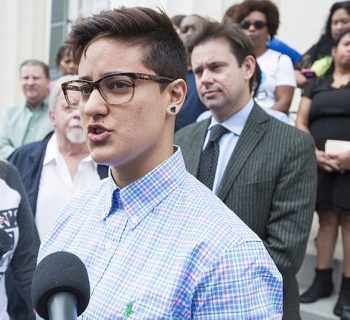By: John Wilkins ~ San Diego Tribune ~ February 21, 2019
The neighborhood kids in Logan Heights took one look at Armando Rodriguez’s dark skin and gave him a nickname: Shadow.
Then he grew up to cast his own light as a pioneering educator and civil-rights activist who served in the administrations of four U.S. presidents.
Rodriguez died Sunday at his home in San Diego from complications of a stroke. He was 97.
“He was a role model for so many people,” said Rachael Ortiz, executive director of Barrio Station, a community services organization. “He never got so high and mighty that he didn’t remember where he was from.”
Born Sept. 30, 1921, in the central Mexican town of Gomez Palacio, the seventh of eight children, Rodriguez was brought to San Diego by his parents when he was 6. He didn’t speak English. The family crowded into a cottage so tiny he had to sleep on the floor.
Briefly forced back into Mexico by Depression-era deportations, the family returned to Logan Heights, where education and sports — especially wrestling — became Rodriguez’s footholds into American culture.
To help his family financially, he sold magazines and tamales door to door. He picked up discarded chunks of ice at an ice factory and outraced the factory’s deliverymen to customers’ doors, selling them the goods at discounted prices.
He served in the U.S. Army during World War II, as a cryptographer in Brazil, and became a U.S. citizen. After the war, he enrolled at San Diego State College (now San Diego State) and got a degree in special education. He played football and coached the wrestling team.
His career in education started in the 1950s at Memorial Junior High School, where he taught and sometimes worked as a truant officer, tracking down students who had cut classes and bringing them back to campus.
“Don’t you know how important education is?” he would tell them, according to Ortiz, who was on occasion one of his targets.
On the side, he was also active in politics, running for a state assembly seat in 1962 — he lost narrowly — and helping to run the “Viva Kennedy” campaign in Southern California during the 1960 presidential election.
After getting a master’s degree at SDSU, Rodriguez moved into school administration, first as a vice principal at Gompers Junior High School and then, in 1965, as a principal at Wright Brothers High, a continuation school. According to his 2007 biography, “From the Barrio to Washington,” he was the first Hispanic principal in the San Diego Unified district.
His stint at Wright Brothers lasted one week. State education leaders lured him to Sacramento to be part of intervention teams that traveled around California tackling various issues.
In a 2012 oral history interview at San Diego State, Rodriguez described his problem-solving approach this way: “I don’t like to take giant steps; I like to take small steps. I’m a small guy and small steps is my mode. And so I look into the future not miles away but yards away.”
But he had no trouble making waves if necessary. In 1967, he and other Hispanic leaders traveled to Albuquerque for a meeting with the federal Equal Employment Opportunity Commission (EEOC). When the commission’s director bowed out of the meeting and sent an assistant with little experience in bias issues, Rodriguez organized a walkout.
That got the attention of President Lyndon Johnson, who appointed Rodriguez to head the Office of Spanish-Speaking American Affairs in the Department of Health, Education and Welfare. He pushed for bilingual classes as a way to help newcomers succeed in school.
Johnson’s successor, Richard Nixon, named Rodriguez to a post as an assistant commissioner of education, but when the president wanted to use pictures of the two of them together as part of his 1972 re-election campaign, Rodriguez — a lifelong Democrat — balked.
He started looking for another job and found one, in 1973, as president of East Los Angeles College, one of the first Hispanics in the state to run an institution of higher learning. He stayed for five years.
“I really enjoyed my stay there,” he said in the SDSU interview. “But you know, like everything else, if you stay there too long you begin to smell. You realize it’s time to leave.”
In 1978, President Jimmy Carter appointed him as a director of the EEOC, a post he retained under President Ronald Reagan until 1983.
Rodriguez remained active in education, working as a consultant and helping to start a computer-literacy program for underprivileged kids.
In a 2002 Union-Tribune interview, Rodriguez reflected on a lifetime of beating the odds and overcoming racial discrimination and other obstacles.
"Now, the sky is the limit," he said. "You still have to compete for a rung on the ladder, but you don't have to justify being out of your own neighborhood."
Survivors include his wife of 70 years, Beatriz; daughter Christy Rodriguez and son Rod Rodriguez; four grandchildren; and three great-grandchildren.
A funeral mass is scheduled for March 5 at 11 a.m. at Our Lady of Guadalupe, the Catholic Church where Rodriguez once served as an altar boy, 1770 Kearney Ave., in Logan Heights.
Source: John Wilkins ~ San Diego Tribune ~ February 21, 2019






